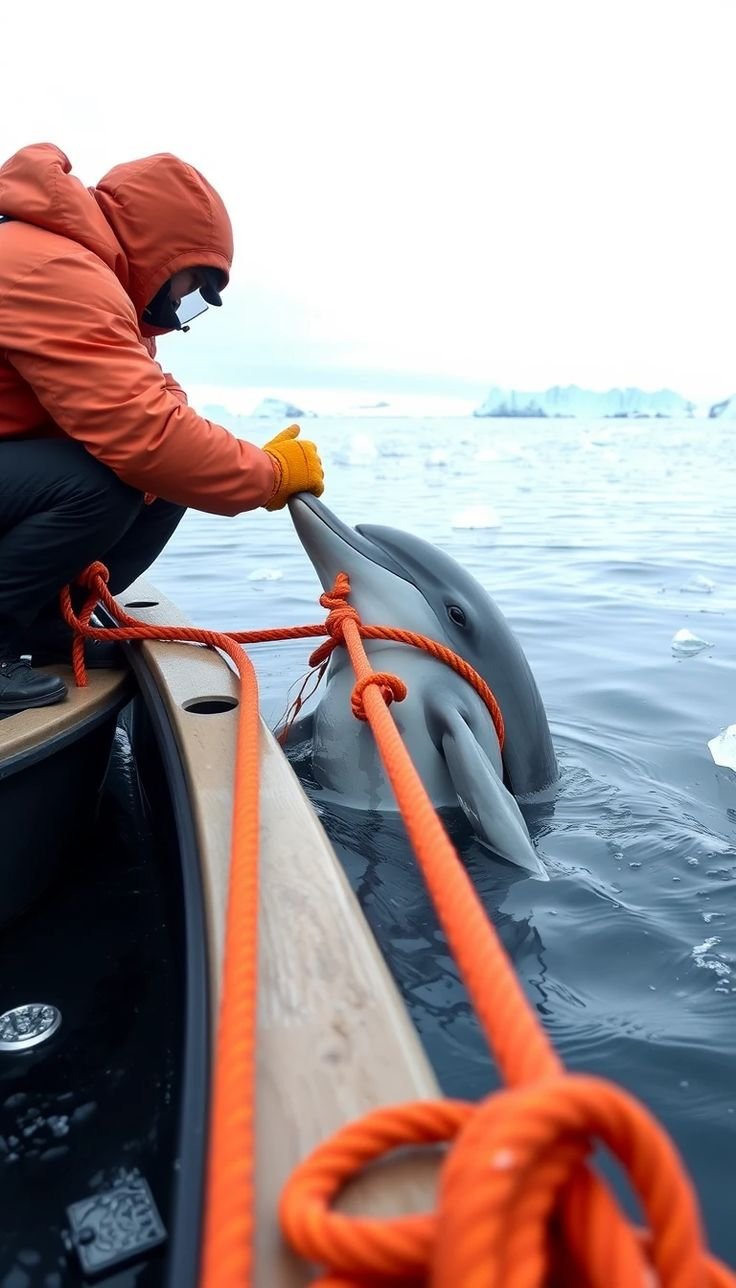A Day at Sea Turns Into a Life-Threatening Ordeal
What began as a peaceful swim off the coast of New Zealand quickly turned into a terrifying brush with death. British tourist Michael Thompson, a seasoned open-water swimmer, found himself at the mercy of nature when a great white shark began circling just meters away. With limited visibility and no nearby boats, it seemed like the worst-case scenario was about to unfold. But what happened next stunned even the most experienced marine biologists and made headlines around the world: a pod of dolphins appeared and formed a protective circle around Thompson, shielding him from the predator.
Witnesses Recall the Heart-Pounding Moments
Onlookers from the shoreline and a nearby lifeguard tower witnessed the unusual scene. According to lifeguard Sarah McIntyre, “At first, we thought it was just a group of dolphins playing. Then we noticed the shark fin, and suddenly everything changed.” Several lifeguards grabbed binoculars and confirmed what they were seeing: dolphins aggressively circling and diving at the shark, keeping it at bay while guiding Thompson toward shallow water.
How Dolphins Defend Humans in the Wild
While it may sound like something out of a Disney movie, this type of dolphin behavior has been documented in the wild before. Dolphins are highly intelligent and social animals with a long history of helping injured or distressed humans and other marine creatures. Marine biologist Dr. Helen Cartwright explains, “Dolphins have been observed intervening in shark attacks, often using their snouts to ram the shark’s gills or underbelly—both sensitive areas. It’s a remarkable display of altruistic behavior that we still don’t fully understand.”
The Moment of Rescue: A Pod’s Tactical Brilliance
Thompson described the moment with a mix of awe and fear. “I felt something rush past me, and then I saw them. At least five dolphins were circling around, and I couldn’t see the shark anymore. I just kept swimming toward the beach.” The dolphins seemed to coordinate with one another, staying close to the swimmer and creating a moving shield that escorted him away from danger. One dolphin even nudged him gently, as if encouraging him to keep going.
Why Do Dolphins Help Humans?
There are many theories, but no concrete answers. Some experts believe dolphins’ instinct to protect is an extension of their complex social structure. They are known to care for injured members of their pod and have even been seen helping other marine species in distress. Others speculate that dolphins may recognize humans as non-threatening beings and extend their protection as a form of interspecies empathy.
Shark Behavior and Why Attacks Happen
Great white sharks are apex predators, but attacks on humans are rare. Often, they are cases of mistaken identity, especially in murky waters where a swimmer might resemble a seal. Dr. Cartwright notes, “The shark in this situation may have been curious or testing its surroundings. Dolphins, recognizing the threat, chose to act preventively.”
The Aftermath: Thompson’s Gratitude and Advocacy
Now safely back on land, Michael Thompson has become a passionate advocate for marine life protection. He believes the dolphins saved his life and has since launched a fundraising campaign to support ocean conservation and dolphin research. “We share this planet with incredible creatures, and we need to protect them just as they sometimes protect us,” he said in an emotional press conference.
Similar Cases Around the World
This isn’t the first time dolphins have played the role of hero. In 2004, a group of lifeguards in New Zealand were protected by dolphins from a great white shark. In another case in California, a surfer reported a dolphin pushing him to shore after a jellyfish sting left him semi-paralyzed. These stories may sound like folklore, but they’re increasingly supported by eyewitness accounts and research.
Scientists Urge Respect and Conservation
While the dolphin rescue has warmed hearts around the world, scientists are urging the public not to romanticize wild animal behavior or seek out close encounters. “These are wild animals that deserve our respect and protection,” says Dr. Cartwright. “Instead of trying to swim with dolphins, support policies that protect their habitats.”
A Glimmer of Hope Amidst Ocean Challenges
With so many negative headlines about marine pollution, coral bleaching, and overfishing, stories like this serve as a reminder of the ocean’s beauty and mystery. Dolphins continue to symbolize intelligence, empathy, and interspecies connection—qualities that humanity can aspire to reflect.
Dolphins as Ocean Guardians: Myth or Reality?
For centuries, dolphins have been revered in mythology and seafaring culture as protectors and guides. Ancient Greek legends spoke of dolphins rescuing sailors, and Polynesian lore treats them as sacred beings. Modern stories like Thompson’s lend weight to the idea that these age-old tales may have roots in real events. “Whether it’s myth or biology,” says Dr. Cartwright, “there’s something undeniably magical about a dolphin’s connection to humans.”
The Role of Conservation in Protecting Dolphin Behavior
Without strong marine conservation efforts, the habitats that support dolphins are at risk. Pollution, climate change, and human activity all threaten their safety. Organizations worldwide are working to enforce marine protected areas (MPAs), reduce plastic waste, and fund dolphin behavioral research.
Takeaway: Nature’s Silent Heroes
Michael Thompson’s story is a poignant example of how the natural world sometimes intervenes in extraordinary ways. While we may never fully understand why dolphins chose to help him, their actions serve as a powerful reminder of our shared existence on this planet. In a world often dominated by chaos and conflict, the silent guardians of the sea offer a message of hope, unity, and respect.


